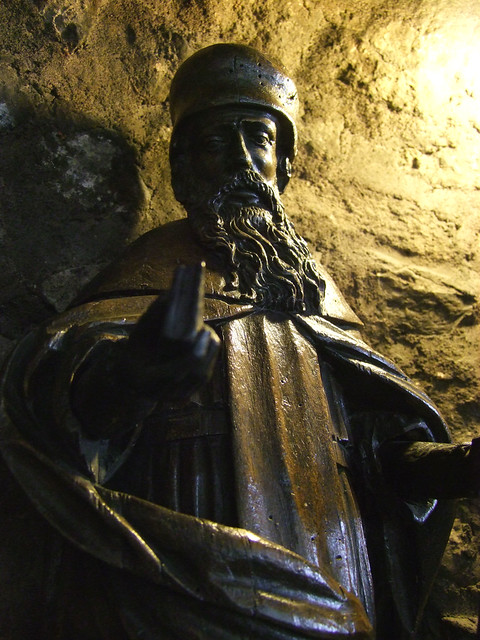| Probably the busiest and
most visited of all the City churches, and one of
the City's largest. A daughter house to Barking
Abbey in Essex, there was a church here by the
end of the first millennium - thus, the church
predates its huge neighbour, the Tower of London.
The church was rebuilt over the centuries, the
tower being replaced as late as the 1660s after a
1649 explosion in a nearby gunpowder warehouse
had made the old one unsafe. All Hallows seems to have been a
fairly High Church parish which enthusiastically
embraced the reforms of Archbishop Laud in the
early 17th Century. This, of course, enraged the
puritans, for whom the City of London was a power
base. Elizabeth and Wayland Young recall that the
churchwarden of All Hallows was accused of
idolatry and popish practices because he allowed
the presence of a statue of a Saint in the
church. In his defence he is said to have replied
that it stood there so many years, and had
done no miracle, therefore we conceived it could
not be a Saint. They had it burned anyway.
Ironically, Laud himself would be briefly
interred at All Hallows after his execution in
the Tower, before being moved elsewhere in kinder
and more gentle times.
In general, the late
medieval Perpendicular church survived the Great
Fire of 1666, the progress of which was watched
from the top of the new tower by Samuel Pepys.
The City Corporation checked the progress of the
conflagration by blowing up surrounding houses to
make firebreaks. The flames reached within a few
feet of the church and scorched the porch, that
was all.
The wealth of the Parish in
the late 17th Century allowed for a rich
refurnishing in the style of the day, including a
font cover and probably a reredos by Grinling
Gibbons, as well as a range of heraldic glass.
There were several restorations in the Victorian
era, but at the start of the 20th Century the
writer AE Daniell could state that the
general appearance of the interior has probably
changed but little during the last two centuries
and a half.
However, the church was
completely gutted in the firestorm of the night
of December 29th 1940. All that was left standing
were the tower, parts of the arcades and the
outer walls. The restoration proceeded after the
War under the capable hands of Seely & Paget,
and the church was rededicated in 1957. The
result is a large, open space with a crisp,
Festival of Britain freshness to it in a style
that might be reasonably described as Concrete
Perpendicular. Into this clean space the new
furnishings have been added thoughtfully and
sparingly. Some of them are old - the 17th
Century pulpit was rescued from St Swithin,
destroyed the same night. The shell-like sounding
board by Seely & Paget above it is splendid -
I think it looks like a scallop shell, but Simon
Bradley in the revised Pevsner thought it a
flat bracket fungus.
The reredos is by Brian
Thomas, better known for his windows at St Vedast
and St Sepulchre. The rich font cover by Grinling
Gibbons had been put into storage and so survived
the bombs. With its abundance of flowers and
fruits, it is generally considered one of the
very best examples of English carving of the
period. Indeed, everything here is of the highest
quality, and yet there was no attempt to create a
homogeneous whole as at St Mary le Bow or St
Bride. It is still possible to wander around here
and be surprised.
And one of the surprises is
the undercroft with its Saxon work revealed by
the bombing and consequent restoration. You reach
it by steps beneath the tower. This is a church
to spend a leisurely hour in, and still be able
to return and notice something you didn't spot
before.
|
|
|
|
|
|
|
|
|
|
|
|
|
|


